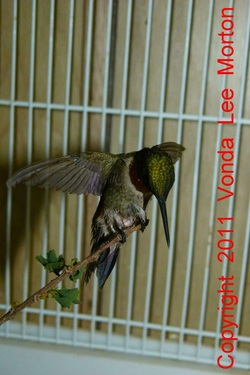
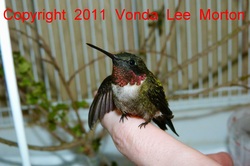
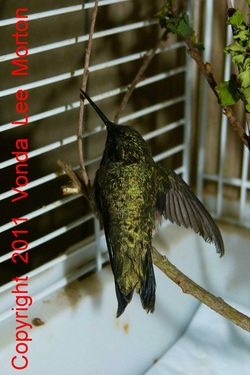
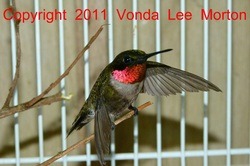
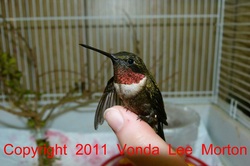
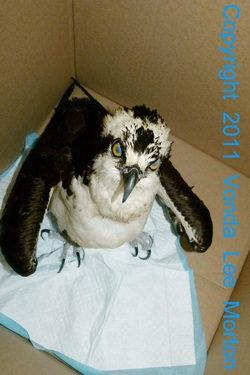

 Go ahead, groan, but how could I resist that name for a ruby-throated hummingbird?! Since his name is bigger than he is, we’ll just call him Dinky for short. Dinky came in with a probable broken right wing; x-rays were inconclusive since we had to set the exposure very low so as not to administer a lethal dose of radiation to the “leetle feller.”  He’d been taken away from a cat (cue standard “indoor-only cats can’t kill birds” rant here…you’ve read it enough in previous posts) several days before I received him; the finder couldn’t get anyone to answer her calls until she got hold of Steve Hicks of Bubba and Friends raptor rehab (www.bubba-and-friends.org). Steve rehabs raptors exclusively, but since he was headed my way the next day to pick up the osprey from the last update, he agreed to take the bird and bring him to me when he came.  Since hummers need to eat every 20 minutes because of their high metabolisms, I was delighted that Dinky was self-feeding. He has been happily slurping a special nectar designed for use in rehab settings, which contains all the nutrients hummers need that normal hummer nectar doesn’t contain. In other words, don’t try this at home, boys and girls! In addition to the fact that it’s illegal without the proper state and federal permits, there’s also the fact that hummers are high-maintenance birds and difficult to rehab.  He may be unreleasable because of that right wing; we’ll have to wait and see. He can flutter it quite well but can get no lift. In the meantime, Dinky is a nosy rascal who often appears to be challenging me: he cocks his little head and flashes his red throat while jealously guarding his “stash” of rehab nectar. Yeah, like I want to drink it; it doesn’t smell all that appetizing to this non-hummer!  Birds in general are amazing, but hummers are especially so. I mean, stop and realize that something so tiny—weighing only a tenth of an ounce, two tenths at the outside—that must eat every 20 minutes to survive, crosses the Gulf of Mexico or hugs the Texas coast each fall, a 500-mile trip that takes nearly 24 hours to complete, to reach their wintering territory. Most hummers don’t survive their first year; those that do have an average life expectancy of 3-4 years. They’re pretty awesome little birds!  LWR also had another osprey come in this past week, this one with matching wing injuries. He had infected, draining spots on both wings below the wrists. We have no clue how he was originally injured; our initial guess was gunshot, but when vet Shelley Baumann of Smalley’s Animal Hospital x-rayed him, there was no lead and there were no broken bones, so it’s anybody’s guess. He’s on antibiotics and will be headed to Bubba and Friends soon.  And just today, we received seven young possums, about three months old. (Trust me, there are 7 in there; they’re in a big pile!) Their mother had been hit by a car, but the finders kept the babies for a week, feeding them only once a day, before getting them to LWR this afternoon. They’re severely malnourished as a result, and the jury’s still out on their fate. I’m hoping they respond well to regular feedings of a proper diet, but we’ll have to see. The squirrels are moving into release phase and have gotten very camera-shy, so no photos of them this week. I’ll see if I can sneak a few for the next update, but they’re pretty sharp bushy-tails and scurry for cover when they see the camera!
1 Comment
While intakes remain slow so far this season, there’s a steady enough trickle to keep me busy. According to reports from rehabbers around the state, slow but steady seems to be everybody’s current situation…which none of us are complaining about after our “banner year” in 2010! Let’s see…this update is a mixed bag… The barnie was released and from all reports is quite happy to be back home. It’s always nice when we get to release adult wildlife back into the wild; too often the adults come in too badly injured to be saved. 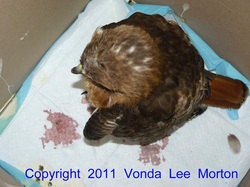 This was, in fact, the case with this gorgeous male red tailed hawk, who had numerous issues. He’d been hit by a car and had head and beak damage, in addition to a broken wing. This paled, however, beside his major problem: he’d apparently eaten a rodent that had eaten rat poison. This probably explained why he’d been hit by the car; he was already dying slowly and painfully as the rodenticide caused him to begin bleeding to death internally. As you can see from the bloody spots around him, he’d begun pooping blood by the time I got him to the vet. The small wound on his wing also refused to clot—a sure sign that rat poison was the culprit. Soapbox time here, people: I realize no one wants rats and mice in their homes, garages, barns—whatever. But there are better ways to deal with them than rat poison, okay? Use rat/mouse traps— humane or snap traps, not glue traps; those are lethal to wildlife, too. Put up an owl nesting box and see if you can encourage a screech owl to move in. According to some people, Bounce dryer sheets will deter rodents. I haven’t tried this so I can’t vouch for it. There are companies that sell a repellant that smells like fox/bobcat urine; this is also one I haven’t tried, but those who have say that it also deters squirrels if you have problems with them. Encourage rat snakes, black snakes and king snakes to take up residence around your property. They’re nonpoisonous and non-aggressive toward anything other than their prey, which includes rattlesnakes, so you get double-duty protection from them. Bottom line: when you use rat poison it moves up the food chain into the predators that eat rodents. The predators that most concern us would be hawks and owls. They die, slowly and painfully, because they ate the very pests you didn’t want around to begin with, and you lose their help in controlling the rodent population. Rat poison is a self-defeating method, in my opinion, for that very reason. Don’t use the nasty stuff! Okay, off the soapbox…for a while, at least. 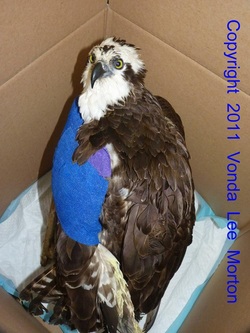 In other raptor news, LWR received its first osprey. Ospreys primarily eat fish, so they’re found near rivers, lakes, etc. This guy was found near a lake and had a broken wing. He was lucky; his break was mid-bone and not too badly displaced, so he has a chance at release. He’ll be going to Bubba & Friends (www.bubba-and-friends.org) soon, where as his wing heals, he’ll get daily PT and flight conditioning. We had another barred owl come right after the last update. He was found by the side of the road by a group of birders, who brought him to me. His left eye was damaged pretty badly but he could see out of the right eye, so we were hopeful all would be well. About two weeks later the damaged eye began to atrophy, which the vets at Smalley’s Animal Hospital had said was a possibility. He had to be euthanized. The youngest squirrel from the last update also had to be euthanized. Once his eyes opened, he turned out to be blind, the poor baby. 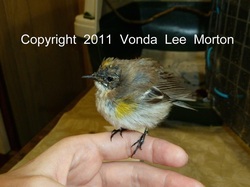 And this female pine warbler was downed in a hailstorm. Nothing was broken; she just refused to eat or fly. She was force-fed and we began antibiotics, as this seemed to be the next logical alternative. The pretty little thing actually seemed to perk up and began flitting about her pen and pecking at things—including me—after the meds kicked in, so I was confident she’d be a success story. The next morning she was dead. This is one of the frustrating aspects of wildlife rehab, as I’ve mentioned before. The really ill or seriously injured animals, you expect not to make it. It always comes as a shock when the ones who respond to treatment and seem to be on the mend keel over overnight. 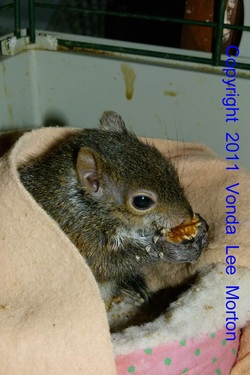 The squirrel whose progress you’ve been following for a couple of months now is doing quite well and attempting to break records for most weight on a squirrel his size. Such a greedy little rascal! 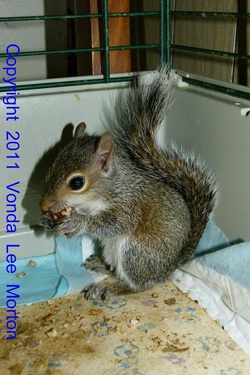 He has a companion, too, another little male. They’re about the same age, so they’re housed together. This little guy was one of two found when someone cut down a tree. Both were taken home, where the people attempted to raise them as pets, feeding them all the wrong foods in the process—for the record, squirrels DO NOT eat bread; cow’s milk will kill them; and pecans are the nutritional equivalent of a candy bar and are used only as treats here at LWR. His brother died of starvation/malnutrition before the people decided to get this little one the professional help he needed. When he came in, he was rail-thin. It took a good week before he began noticeably gaining weight, but he’s making up for lost time now. I can no longer feel every rib on his little body, and he and his “brother” are active, playful little rascals who’re in the process of being weaned now. 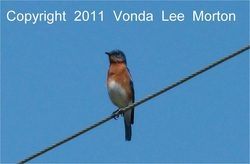 And finally, only two of the white bluebird eggs I mentioned in the last update hatched. I do, however, finally have “blues” nesting in a box they’ve ignored for the three years it’s been up; there are four pretty little eggs in it. And a weekend neighbor has a nesting mama, as well, who also has four eggs. I’m checking all nests daily, as there are so many predators out there and so few bluebirds…and in my admittedly biased opinion, there’s very little prettier than a bluebird! |
Archives
April 2023
Categories
All
|